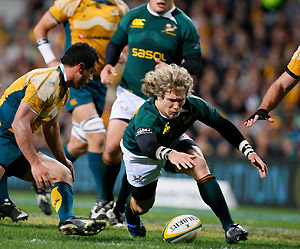
South Africa's Frans Steyn chases the ball forward into attack during the Tri Nations Test match between the Australian Wallabies and the South African Springboks played at the Subiaco Oval in Perth, Saturday July 19, 2008. AAP Image/Tony McDonough
The announcement of the Springboks squad to play the British and Irish Lions gives us a chance to compare it with the Wallaby and All Blacks squads. The first impression is that, on paper at least, the Springboks look to be the strongest of the three squads.
By my count, they have eight forwards – Schalk Burger, Bismarck du Plessis, John Smit, Juan Smit, Pierre Spies, Victor Matfield, Bakkies Botha and Gurthro Steenkamp – who, on current form, would be close first choice selections in any national sides.
Five of the backs, too – Jean de Villiers, Fourie du Preez, Jacque Fourie, Bryan Habana, and J.P.Pietersen – would, similarly, enhance any other national squad.
But there are a couple of qualifications that need to be made.
First, the squad lacks a world class first five-eighths.
Ruan Pienaar, a gifted player, is a converted halfback who plays fullback better than he does five-eighths. Francois Steyn has been tried in the position and has played with leaden hands.
Morne Steyn has been excellent this season in the Super 14, but whether he can lift his steady, essentially kicking game to a higher level remains to be seen.
There is no ‘fetcher’ (in South African parlance), or openside breakaway, as played in Australia or New Zealand, in the squad. The selectors seem to have forgotten that the Bulls were able to play more expansively this year because they played fetchers.
Also, a new ruling at the tackle (which allows a tackler to keep his hands on the ball from the time of the tackle, if he stays on his feet) is going to reward players like George Smith and Richie McCaw, who get their hands first on the ball a lot and, in the past, when a ruck is formed are told to “release it.”
Finally, there is the issue of whether coach Peter de Villiers is up to coaching a successful Springboks side.
Given the political imperatives involved, the job is a difficult one. Why, for instance, is Earl Rose in the squad, if not for reasons of political correctness?
Last season, apparently, the senior members of the Springboks squad took over the coaching themselves at the end of the season. But this sort of player-power action generally does not continue to give results.
So the onus is on the coaching staff to get the best of what is a very strong squad, better in the opinion of Victor Matfield than the side that won the 2007 Rugby World Cup.
The All Blacks, at least until Richie McCaw comes back for the Tri-Nations, and without Sitiveni Sivivatu until the November tour presumably, look to be light on great players. The forwards look solid, but without the special qualities the best of the South African pack has.
In the backs, Ma’a Nonu and Mils Muliaina are genuinely world class players.
Joe Rokocoko looks past his best.
There is great talent in Brendon Leonard and Richard Kahui, if they can get over a propensity to get injured a lot. Isaia Toeava is also a tremendous talent and my guess is that he will used on the wing to play the sort of mid-field attacking role that Sivivatu has played.
The New Zealand selectors did pick Isaac Ross, potentially a great second rower in the Colin Meads tradition of running with the ball. They did not select Rene Ranger, who looked to be a new John Kirwan with his size, pace and power. It may be by Tri-Nations time, Ranger will be brought in if he plays well for the NZ A side in the Pacific tournament.
Graham Henry has an 85 per cent winning record with the All Blacks, the second best (after Fred Allen) apparently. If he can maintain this sort of record this season, with players like Dan Carter and McCaw unavailable for some of the Tests, it will be a great coaching achievement.
Matt Giteau sums up the hopes and the dilemma of the current Wallaby squad when he told journalists on Monday that the side will show ‘more hunger’ this season. The days of automatic selection for senior players are over because “Robbie’s for everyone challenging for positions.”
And by everyone, that means Giteau himself.
It would not surprise me if sometime this season Giteau is moved to inside centre and Berrick Barnes is brought in to run the backline.
The Wallabies are short of power in the second row, where James Horwill is coming back from an injury and Nathan Sharpe is coming into the Wallaby squad after being dropped (correctly) at one stage last year. Dean Mumm is the third second rower, although his favoured position is blindside flanker.
That position will be filled by Rocky Elsom, and the Elsom, George Smith, Wycliff Palu backrow is as strong a line as any team could hope to have.
I always like teams selected with a bit of growth in them, and James O’Connor provides that for the Wallabies.
This boy wonder is certain to be a great Wallaby and Deans, by playing him at fullback, is nurturing him the way he did with Carter at the Crusaders.
Like the All Blacks, the point of difference for the Wallabies compared with the Springboks is some new exciting talent and, more importantly, the ability of the coach to create a team that is greater than the sum of its parts.
De Villiers has the players, it seems to me. The inferior Wallaby and All Blacks squads have the superior coaches.





























































































